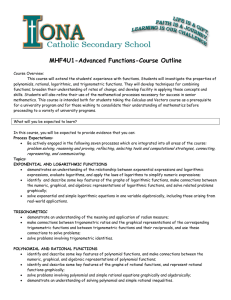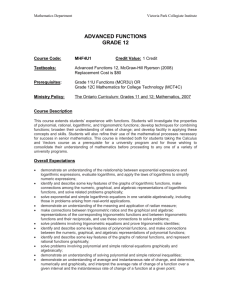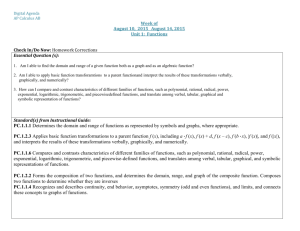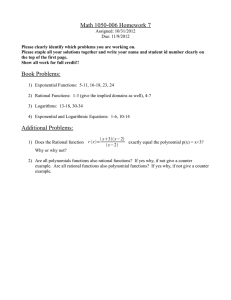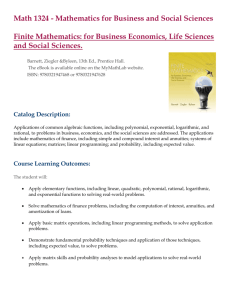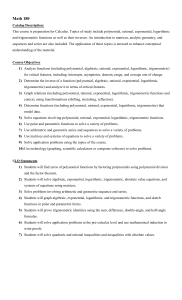Grade 12, University Department of Mathematics St. Edmund Campion Secondary School
advertisement
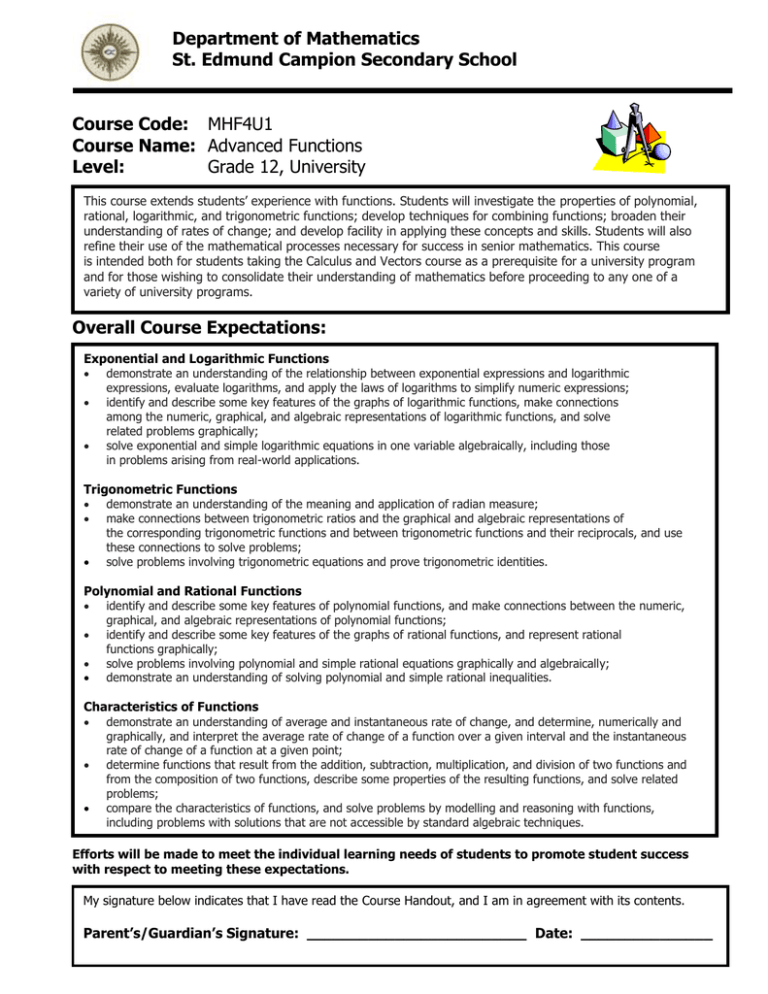
Department of Mathematics St. Edmund Campion Secondary School Course Code: MHF4U1 Course Name: Advanced Functions Level: Grade 12, University This course extends students’ experience with functions. Students will investigate the properties of polynomial, rational, logarithmic, and trigonometric functions; develop techniques for combining functions; broaden their understanding of rates of change; and develop facility in applying these concepts and skills. Students will also refine their use of the mathematical processes necessary for success in senior mathematics. This course is intended both for students taking the Calculus and Vectors course as a prerequisite for a university program and for those wishing to consolidate their understanding of mathematics before proceeding to any one of a variety of university programs. Overall Course Expectations: Exponential and Logarithmic Functions demonstrate an understanding of the relationship between exponential expressions and logarithmic expressions, evaluate logarithms, and apply the laws of logarithms to simplify numeric expressions; identify and describe some key features of the graphs of logarithmic functions, make connections among the numeric, graphical, and algebraic representations of logarithmic functions, and solve related problems graphically; solve exponential and simple logarithmic equations in one variable algebraically, including those in problems arising from real-world applications. Trigonometric Functions demonstrate an understanding of the meaning and application of radian measure; make connections between trigonometric ratios and the graphical and algebraic representations of the corresponding trigonometric functions and between trigonometric functions and their reciprocals, and use these connections to solve problems; solve problems involving trigonometric equations and prove trigonometric identities. Polynomial and Rational Functions identify and describe some key features of polynomial functions, and make connections between the numeric, graphical, and algebraic representations of polynomial functions; identify and describe some key features of the graphs of rational functions, and represent rational functions graphically; solve problems involving polynomial and simple rational equations graphically and algebraically; demonstrate an understanding of solving polynomial and simple rational inequalities. Characteristics of Functions demonstrate an understanding of average and instantaneous rate of change, and determine, numerically and graphically, and interpret the average rate of change of a function over a given interval and the instantaneous rate of change of a function at a given point; determine functions that result from the addition, subtraction, multiplication, and division of two functions and from the composition of two functions, describe some properties of the resulting functions, and solve related problems; compare the characteristics of functions, and solve problems by modelling and reasoning with functions, including problems with solutions that are not accessible by standard algebraic techniques. Efforts will be made to meet the individual learning needs of students to promote student success with respect to meeting these expectations. My signature below indicates that I have read the Course Handout, and I am in agreement with its contents. Parent’s/Guardian’s Signature: _________________________ Date: _______________ Course Outline: Unit Unit Unit Unit Unit Unit Unit 0 1 2 3 4 5 6 Resources: Introductory Unit Polynomial Functions Rational Functions Exponential and Logarithmic Functions Trigonometry, part 1 Trigonometry, part 2 Characteristics of Functions Summative Assessment & Review Activities The course will use a variety of resources. There is no primary textbook, but on occasion, textbooks may be distributed to students for a brief period. The text and all other resources assigned to each student are the responsibility of the student. Any damage incurred will result in payment for replacement. Replacement cost for any text used is $75.00. 9 days 17 days 7 days 12 days 10 days 11 days 13 days 6 days Summative Assessment will be administered towards the end of the course and may include culminating activities and/or a formalized final examination. (All timelines are approximate.) Evaluation Policies 1. Student marks will be determined by evaluating process & product according to 4 categories (see below) & 4 levels of the Achievement Chart as found in the Ministry Policy document for Mathematics. Evaluation Structure: Knowledge/Understanding Application Communication Thinking/Inquiry 30% 30% 20% 20% Term work = 70% of the final mark. Summative work = 30% of the final mark. 2. Feedback will also be provided for student learning skills. Working independently, teamwork, organization, work habits/homework, and initiative are assessed apart from student achievement in the four categories outlined above and will conform to the coding: E – Excellent G – Good S – Satisfactory N - Needs Improvement 3. Assignments submitted after the due date established by the teacher will receive a penalty in accord with our school evaluation policy as outlined in the agenda. No assignment will be accepted once a teacher has returned marked assignments. Chronic lateness indicates poor organization skills and will result in parental contact and be reported in the learning skills section of the report card. 4. Should a student miss an evaluation due to a legitimate absence, a note shall be provided to the teacher the day of the student’s return to class stating the reason for absence and the parent/guardian’s awareness that the student has missed an evaluation. Makeup will be at the teacher’s discretion. Should such documentation not be provided, a mark of zero will be assigned. May God bless your efforts this semester!

